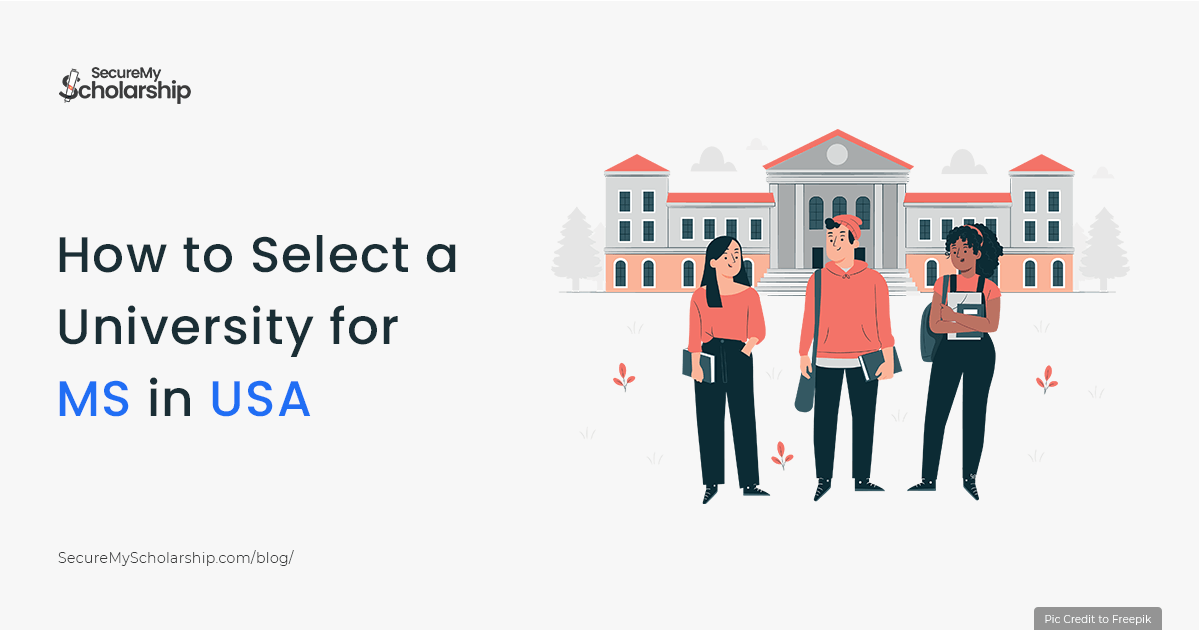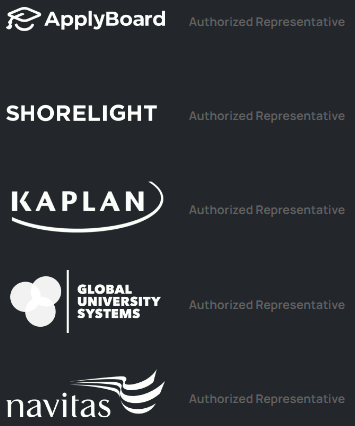How to Select a University for MS in US in 2025 – Deciding to pursue a Master’s degree in the United States can be a daunting task. With literally thousands of universities to choose from, how do you select the right one? The most crucial factor is to find a program that meets your specific needs and interests. Each university has its strengths and weaknesses, so it is essential to research before making a final decision. This blog post will discuss some factors you should consider when choosing a university for your MS degree in the United States.

Which Factors to consider while shortlisting universities for MS in USA?
1. Academic Reputation
One of the most important factors to consider when choosing a university is its academic reputation. This can be measured in several ways, such as the number of Nobel Prize winners associated with the university, its faculty quality, and its graduates’ research output.
2. Course/Stream Choice of Your Interest
Be sure to pick a university that offers the specific courses and streams you are interested in. Each university has its strengths and weaknesses, so it is crucial to find one that specialises in your area of interest.
3. Course Duration
Master’s programs in the United States typically last two years. However, some universities offer three-year programs. Consider your situation and decide which duration is suitable for you.
4. Cost of Attendance
The cost of attendance varies greatly from one university to another. Make sure to consider the total cost of attendance, including tuition, fees, room and board, books and supplies, transportation, and other personal expenses.
5. Location
The university’s location can also be an essential factor to consider. If you prefer a big city, you’ll want to look at universities located in urban areas. If you select a more rural setting, you’ll want to look at universities in smaller towns or cities.
6. Cost of Tuition and Living Expenses
Tuition and living expenses vary significantly from university to university. Consider the total cost of attendance before making a final decision.
7. Job Opportunities
The job market in the United States can be very competitive, so choosing a university that offers good job prospects after graduation is essential. Be sure to research the employment rates of graduates from different universities before making a final decision.
8. Friends & Relatives
If you have friends or relatives who live in the United States, they may be able to help you with your decision. Ask them for their opinion on different universities and see if they know anyone who has attended the university you are considering.
9. Weather Conditions
The weather conditions in the United States can vary significantly from one region to another. Be sure to research the climate of the region where the university is located before making a final decision.
10. Accreditation
Finally, check that a recognised accrediting body accredits the university you are considering. This will ensure that employers and other universities will recognise your degree.
How Many Universities Must You Shortlist for MS?
Generally, many students have this question about how many universities they must apply to. The truth is that there is no definite answer as it varies from person to person. If you are an average student, applying to 5-7 colleges is advisable. However, if your grades are not up to the mark, you must increase the number of applications.
To sum up, these were some significant factors that one must remember while zeroing in on the universities for their MS degree course in the United States.
The cost split of application to the foreign university is as follows:
– Application fee – 75$
– GRE test – 205$
– TOEFL Test – 170$
– IELTS Test – 185$
– Visa fee – 160$
– Health and Insurance – 2,200$ per year
The total cost would come around to be 3000 $ without accommodation charges.
What is the best time to Apply for MS in Spring or Fall in 2025?
There are two semesters in the United States- Spring and Fall. Most students prefer to pursue their MS course during the fall semester as the universities have a better reputation, and also, it increases their chances of getting financial aid from the university.
The application process for both Spring and Fall is more or less the same, with a few variations. The deadlines for Fall are generally in December, and for Spring, they are in August.
The average cost of studying MS in the USA is about 30-40 lakhs for 2 years, including tuition fees, hostel accommodation, food and other living expenses. The United States of America is one of the most sought-after destinations for students pursuing their master’s abroad. The country offers a vast array of courses for students and boasts of world-renowned universities that rank high globally.
How to Apply to MS in US?
The first step is to take the GRE (Graduate Record Examination) and TOEFL (Test of English as a Foreign Language) or IELTS (International English Language Testing System) tests. Most universities in the United States require these tests.
Next, you need to shortlist the universities you want to apply to. Make sure you check the requirements of each university before using.
Once you have shortlisted the universities, you need to complete the online application form and submit it with your transcripts, GRE/TOEFL/IELTS scorecard, personal statement, resume and letters of recommendation.
After the university reviews your application, you will be invited for an interview. If you are successful in the interview, you will be offered admission to the university.
Finally, you must obtain a student visa from the United States Embassy or Consulate.
What is the Difference Between MS and MBA?
The main difference between MS and MBA is that MS is a technical degree while MBA is a professional degree. MS focuses on developing your technical skills, while MBA develops your business and management skills.
MS is generally pursued by students who want to pursue a career in research or academia, while MBA is followed by students who wish to enter the corporate world. MS takes about 2 years to complete, while MBA takes about 2 years.
The average cost of studying MS in the USA is about 30-40 lakhs for 2 years, including tuition fees, hostel accommodation, food and other living expenses. The average cost of studying MBA in the USA is about 60-70 lakhs for 2 years, including tuition fees, hostel accommodation, food and other living expenses.
What to Prepare and Send Application for MS in US?
Here is the list of documents needed to send an application for MS in US:
1. Cover Letter
The cover letter is a one-page document that introduces you to the university and states your interest in the program. It should be addressed to the graduate admissions committee.
2. CV or Resume
Your CV or resume should include your personal information, educational background, work experience (if any), research experience (if any), awards and accomplishments, and extracurricular activities.
3. Marksheets and Transcripts
You need to submit your mark sheets and transcripts from your bachelor’s degree. If your transcripts are not in English, you must get them translated and notarized.
4. Scorecards for TOEFL and GRE
You must take the TOEFL or IELTS test to prove your English proficiency. You must also take the GRE (Graduate Record Examination) test.
5. Letters of Recommendation
You must submit at least 2 letters of recommendation from your professors or employers. These letters should attest to your academic or professional abilities.
6. Photocopy of passport
You must submit your passport photocopy to prove your identity and nationality.
7. Bank statement proof
You need to submit a bank statement or sponsorship letter to prove that you have the financial resources to cover your tuition fees and living expenses.
8. Personal Statement
Your personal statement is a chance to tell the university about your goals, motivations, and experiences. It should be well-written and free of grammatical errors.
9. Affidavit of Support
The affidavit of support is a document filed by your sponsor (usually a parent or guardian) to prove that they can financially support you during your studies in the United States.
1. Recent program changes in How to Select a University for MS in US
1.1 Test-Optional Policies
- Trend: Many U.S. universities have started adopting test-optional or test-flexible policies (especially after 2020). While GRE is still commonly required, an increasing number of institutions either waive it for certain programs or accept alternative criteria.
- How to Incorporate: Advise prospective MS students to confirm whether GRE/GMAT or other standardized tests are optional or mandatory for the programs they’re considering, and explain how skipping or taking the GRE might impact their application.
1.2 Online/Hybrid Learning Models
- Trend: Some universities now offer robust online or hybrid programs, allowing students more flexibility in terms of location and part-time work.
- How to Incorporate: Talk about how students can evaluate whether an online program might fit their schedules, career goals, and budget. Provide pointers on accreditation and whether online MS degrees are equally recognized in their field.
1.3 Growing Fields & Specializations
- Trend: Fields like Artificial Intelligence, Data Science, Cybersecurity, and Renewable Energy continue to see high demand. Emerging areas might have better funding opportunities or career prospects.
- How to Incorporate: Encourage students to check faculty expertise, department research output, and industry tie-ups to find a program that aligns with fast-growing sectors.
2. Know More About How to Select a University for MS in USA
2.1 Cost of Living vs. Tuition
- Beyond Tuition: Students often overlook living expenses, which can vary significantly from city to city (e.g., large metropolitan areas like New York vs. college towns like Ann Arbor).
- How to Incorporate: Add a side-by-side comparison of typical monthly costs in different regions. Highlight that sometimes a higher-ranked university in a smaller city can be more cost-effective than a mid-ranked one in a high-cost city.
2.2 Campus Culture & Student Life
- Importance: A university’s culture—whether academically rigorous, research-oriented, or collaboration-focused—can impact a student’s motivation and mental health.
- How to Incorporate: Suggest students look up campus community features like student clubs, cultural associations, on-campus events, and diversity statistics. Direct them to resources such as the university’s “student life” webpage or connect with current students on platforms like LinkedIn or Facebook.
2.3 Alumni Network & Career Support
- Key Factor: A strong alumni network can lead to valuable job connections or mentorship opportunities. Universities with a proven track record of job placements often have robust career services.
- How to Incorporate: Encourage readers to look for placement reports, career fairs, and partnerships with local companies. Mention that networking events and campus recruiting can significantly boost job prospects post-MS.
2.4 Faculty Research & Lab Facilities
- Why It Matters: For students aiming to do research or a thesis-based MS, faculty expertise and well-equipped labs can be a game-changer.
- How to Incorporate: Suggest ways to review faculty profiles, read through their published papers, and check the availability of funded research projects or assistantships.
2.5 Accreditation and Licensure (for Certain Fields)
- Importance: Fields like Engineering, Healthcare, or Psychology might need programmatic accreditation for licensing.
- How to Incorporate: Remind students to confirm that the program meets the accreditation requirements if their ultimate goal involves a professional license in the U.S.
Conclusion
Getting an MS degree from US will give you higher career opportunities as you may get a chance to work in top-level companies. If you are someone who did not complete graduation from US University, you might have to create a lot of documents, which is why SecureMyScholarship is here to help you. Our academic counsellors will guide you throughout the admission process. Thus, don’t just wait; contact us and guarantee your seat and secure your scholarship.
FAQs about How to Select a University for MS in US
Q1. What are the benefits of doing masters in USA?
The US Universities are of high academic standards and are top ranking across the globe. The US Universities has enriched classroom and teaching experience. After you complete your degree, you get opportunities to get high paying jobs.
Q2. Which master’s degree is most in demand in USA?
Most in demand master’s degree are as follows:
– MBA (Masters in Business Administration)
– MS (Master in Science)
– Computer Sciences
– Health Management
– Human Resource Management
– Mathematics
Q3. Do master’s students get paid in USA?
In USA, mostly students option for STEM courses may get paid like a stipend amount but not for every masters courses students get paid.
Q4. Can we work while doing masters in USA?
Yes, you can work while doing masters in USA. You may get 20 hours in a week to work, here mostly students go for an internship or a part time job to further continue their education.
Q5. Do international students get job in USA?
Yes, international students get jobs in USA. After you have completed your MS, the University will provide you the opportunity to sit for the campus placements and give you guidance to clear the interview of top multinational companies.
Q6. What is the minimum salary after MS in USA?
After completing MS in US, you may get a minimum salary of $75k – $100k per year i.e Rs. 50,00,000 – Rs. 70,00,000 per year.
Q7. How can I evaluate if a university’s curriculum aligns with my career goals?
A great way is to carefully review the course catalog and departmental website. Look for the specific electives, research labs, or capstone projects that match your interests. If you’re aiming for a certain industry (like AI, Healthcare, or Renewable Energy), make sure the curriculum covers those skill sets. You can also email current students or professors to get insights on how well the coursework prepares you for real-world roles.
Q8. Should I look into a university’s accreditation status?
Absolutely. For most MS programs, regional accreditation is standard in the US. But if you’re in fields like Engineering, Nursing, or Architecture, check for programmatic accreditations (like ABET for engineering). Accreditation matters not only for the quality of education but also for future licensure or certification requirements.
Q9. Is a thesis-based MS better than a coursework-only option?
It depends on your goals. A thesis-based MS is often research-intensive and is great if you plan to pursue a PhD or a research career. A coursework-based MS might be better if you’re more focused on practical skills or industry jobs. Check if the department’s faculty are open to supervising a thesis and if you have the time and resources to commit to research.
Q10. How can I estimate the cost of living in different states or cities?
Try checking resources like Numbeo or official university websites for approximate housing, food, and transportation costs. Compare living expenses between major cities (e.g., New York, San Francisco) and smaller college towns (e.g., Gainesville, Ann Arbor). Remember, sometimes a higher-ranked school in a lower-cost area can balance out your budget better than a moderate-ranked school in an expensive city.
Q11. Is it possible to switch specializations or departments once I start my MS?
Switching can be tricky. Some universities allow you to switch specializations within the same department (like from Computer Engineering to Software Engineering). Changing entire departments (say, from Mechanical Engineering to Business Analytics) may require you to meet additional prerequisites or reapply. If flexibility is important to you, confirm these details by contacting admissions or looking at the department guidelines before you commit.
Q12. Does the university’s alumni network actually make a difference?
Yes—big time. A strong alumni network can open doors for internships, job referrals, and mentorship. Many universities host alumni events, and some graduates actively recruit from their alma mater. Look for schools that track alumni outcomes and success stories. Connecting with alumni through LinkedIn or university forums can provide a more personal perspective on the program.
Q13. How do I compare job placement rates across universities?
A growing number of schools publish graduate employment reports or “career outcome” statistics right on their websites. These might show salary ranges, employment sectors, and top hiring companies. If this data isn’t publicly available, consider emailing the career services office or talking to current students. Higher job placement rates might indicate stronger industry ties and support.
Q14. What about research grants or funding opportunities beyond scholarships?
Depending on your program, you might qualify for research or teaching assistantships, which can significantly cut tuition costs. Some departments also receive external grants (from the government or private companies) for specific research projects. Check department webpages for faculty research listings and see if they mention grant-funded openings for grad students.
Q15. Is it worth applying to universities that are slightly above my academic profile?
Sometimes, yes. It’s common to have a balanced list—some “safe” universities, some “match” schools, and a few “reach” schools. You never know; a strong Statement of Purpose, stellar recommendation letters, or relevant work experience can tip the scales in your favor. Just ensure you also have practical fallback options.
Q16. Should I contact potential professors or advisors before applying?
Reaching out can help if you have a focused research interest and want to see if they’re open to taking new grad students. Personalizing your SOP with details from these conversations can also make your application stand out. However, not all professors may respond quickly, especially during busy academic periods, so don’t be discouraged if you don’t hear back right away.




